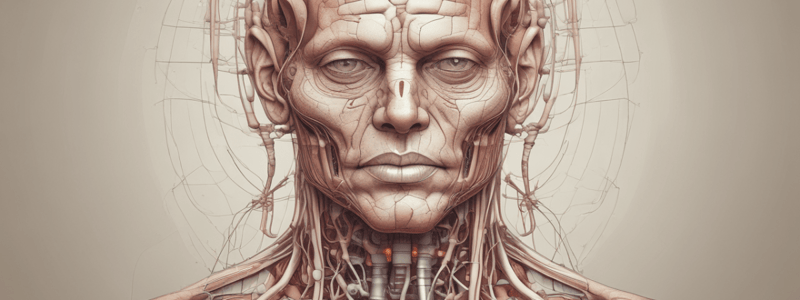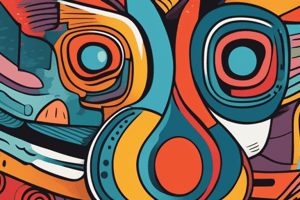Podcast
Questions and Answers
What is the primary function of the proximal urethral sphincter?
What is the primary function of the proximal urethral sphincter?
- To regulate bladder emptying
- To inhibit pelvic floor relaxation
- To aid in detrusor contraction
- To prevent urine loss (correct)
What happens to the urethral resistance during normal bladder filling?
What happens to the urethral resistance during normal bladder filling?
- It remains constant
- It fluctuates randomly
- It increases gradually (correct)
- It decreases gradually
What triggers the micturition reflex?
What triggers the micturition reflex?
- Stretch receptors in the pelvic floor
- Pain receptors in the bladder neck
- Tension receptors in the bladder (correct)
- Pressure receptors in the urethra
What is the function of the autonomic nervous system in the lower urinary tract?
What is the function of the autonomic nervous system in the lower urinary tract?
What is the purpose of the detrusor muscle contraction?
What is the purpose of the detrusor muscle contraction?
What is the arrangement of smooth muscle fibers in the male urethral orifice?
What is the arrangement of smooth muscle fibers in the male urethral orifice?
What happens to the pelvic floor during micturition?
What happens to the pelvic floor during micturition?
What is the total length of the male urethra?
What is the total length of the male urethra?
What is the name of the nerve responsible for innervating the external sphincter and pelvic floor muscles?
What is the name of the nerve responsible for innervating the external sphincter and pelvic floor muscles?
What is the term for the involuntary loss of urine associated with a strong desire to void?
What is the term for the involuntary loss of urine associated with a strong desire to void?
What is the name of the muscle that is weakened in stress incontinence?
What is the name of the muscle that is weakened in stress incontinence?
What is the term for the involuntary loss of urine during coughing, sneezing, or physical activity?
What is the term for the involuntary loss of urine during coughing, sneezing, or physical activity?
What is the name of the theory that explains the transmission of intra-abdominal pressure to the bladder and urethra?
What is the name of the theory that explains the transmission of intra-abdominal pressure to the bladder and urethra?
What is the term for the combination of symptoms of urge and stress incontinence?
What is the term for the combination of symptoms of urge and stress incontinence?
What is the name of the nerve responsible for filling the bladder?
What is the name of the nerve responsible for filling the bladder?
What is the term for the involuntary loss of urine associated with overdistension of the bladder?
What is the term for the involuntary loss of urine associated with overdistension of the bladder?
What is a characteristic of a bladder that is unable to fully empty?
What is a characteristic of a bladder that is unable to fully empty?
Which of the following management options is not a type of electrical stimulation?
Which of the following management options is not a type of electrical stimulation?
What is the minimum age requirement for a child to be diagnosed with Enuresis?
What is the minimum age requirement for a child to be diagnosed with Enuresis?
What is the function of anti-diuretic hormone (ADH) in preventing bedwetting?
What is the function of anti-diuretic hormone (ADH) in preventing bedwetting?
What is the primary function of the posterior pituitary gland in relation to bedwetting?
What is the primary function of the posterior pituitary gland in relation to bedwetting?
What is the term for the inability to void when the urge is felt?
What is the term for the inability to void when the urge is felt?
What is the most common cause of bedwetting in children?
What is the most common cause of bedwetting in children?
What is the recommended approach to treating bedwetting in children?
What is the recommended approach to treating bedwetting in children?
What is a beneficial strategy for helping children achieve nighttime dryness?
What is a beneficial strategy for helping children achieve nighttime dryness?
What is the purpose of a star chart in the treatment of bedwetting?
What is the purpose of a star chart in the treatment of bedwetting?
What is a common classification of enuresis in children?
What is a common classification of enuresis in children?
What is a potential consequence of punitive measures in the treatment of bedwetting?
What is a potential consequence of punitive measures in the treatment of bedwetting?
Study Notes
Physiology of Micturition
- The smooth muscle of the bladder wall (detrusor muscle) is composed of an interlacing network of fibers running in various directions.
- The male urethra consists of prostatic, membranous, and spongy parts, with a total length of about eight inches.
- The proximal urethral sphincter can maintain passive continence, but opens widely in association with a detrusor contraction.
- During normal filling, there is a gradual increase in urethral resistance, which helps to prevent urine loss as the bladder fills.
- The detrusor should remain inactive with no involuntary contractions during filling.
- When the bladder has filled to a specific volume, tension receptors in the bladder sense fullness, and a voluntary micturition reflex is initiated.
Neural Supply for the Lower Urinary Tract
- The autonomic nervous system innervates the smooth muscle detrusor and proximal sphincters.
- The somatic nervous system innervates the striated external sphincter and pelvic floor muscles.
- The sympathetic nervous system is responsible for filling, while the parasympathetic nervous system is responsible for emptying.
Reversible Causes of Urinary Incontinence
- Delirium
- Infection
- Atrophic vaginitis
- Pharmacological
- Psychological
- Endocrine
- Restricted mobility
- Stool impaction
Types of Urinary Incontinence
- Urge Incontinence: involuntary loss of urine associated with a strong desire to void (urgency), often associated with detrusor instability.
- Stress Incontinence: involuntary loss of urine during coughing, sneezing, laughing, or physical activity that increases intra-abdominal pressure.
- Mixed Incontinence: a combination of symptoms of urge and stress incontinence.
- Overflow Incontinence: involuntary loss of urine associated with overdistension of the bladder.
Management of Urinary Incontinence
- Kegel exercises
- Behavioral therapy
- Functional Magnetic Stimulation (FMS)
- Electrical Stimulation
- Biofeedback
- Acupuncture
Electrical Stimulation
- Surface stimulation: TENS, functional electrical stimulation, pudendal nerve stimulation, lower limb stimulation, functional magnetic stimulation, interferential stimulation, posterior tibial nerve stimulation.
- Neuro-modulation: intravesical electrical stimulation, direct bladder stimulation, implanted sacral root stimulation.
Enuresis (Bed-wetting)
- Defined as repeated voiding of urine into clothes or bed at least twice a week for at least 3 consecutive months in a child who is at least 5 years old.
- Two physical functions prevent bedwetting: anti-diuretic hormone (ADH) production and the ability to wake up when the bladder is full.
- Classification of enuresis: daytime symptoms, nocturnal symptoms, mono-symptomatic, poly-symptomatic, primary, secondary.
Causes of Bed-wetting
- Neurological-developmental delay
- Genetics
- Bladder problems
- Insufficient anti-diuretic hormone (ADH) production
- Psychological
- Infection/disease
- Sleep disorders
- Improper toilet training
PT Treatment of Enuresis
- Reassure the child and parents that the condition is self-limited and avoid punitive measures.
- Proper toilet training
- Behavioral treatment
- Alarm treatment
- Acupuncture
- Motivation and psychological support
- Fluid intake restriction after 6 or 7 pm
- Voiding at bedtime
- Avoiding extraneous caffeine and diuretic fluids after 4 pm
- Star chart for dry nights
- Waking children a few hours after they go to sleep to have them void often allows them to awaken dry.
Studying That Suits You
Use AI to generate personalized quizzes and flashcards to suit your learning preferences.
Related Documents
Description
Learn about the physiology of micturition, types of voiding dysfunction, and proper PT modalities for treating voiding disorders. Understand the anatomy of the bladder wall and urethral orifice.




